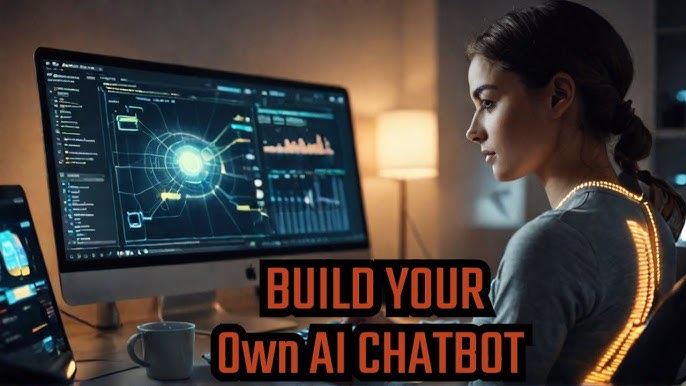From basic support tools to intelligent digital assistants that can interact with people, automate processes, and run entire businesses, AI chatbots have come a long way. By 2025, creating an AI chatbot will be simpler than ever before, even for non-developers, due to developments in generative AI, natural language processing (NLP), and no-code tools.
Whether you’re a startup founder, marketer, or curious entrepreneur, this guide will walk you through how to make an AI chatbot from scratch in 2025 using modern tools and best practices.
What Is an AI Chatbot?
An AI chatbot is a virtual assistant that uses artificial intelligence to comprehend, process, and conversationally respond to human input. In contrast to rule-based bots, contemporary AI chatbots manage dynamic, human-like discussions by utilizing machine learning, LLMs (such as GPT-4.5), and contextual memory.
In 2025, AI chatbots will be used for:
- Customer support
- Lead generation
- E-commerce assistance
- Healthcare triage
- Appointment booking
- Employee help desks
- And much more
Why Make an AI Chatbot in 2025?
- 24/7 Customer Engagement
- Reduce Operational Costs
- Increase Conversions & Lead Capture
- Personalized User Experiences
- Scalable Support Across Channels
- Data Collection & Insights in Real Time
With AI technology now more accessible than ever, even non-technical users can create functional chatbots using prebuilt platforms or APIs.
Step-by-Step Guide: How to Make an AI Chatbot in 2025
Step 1: Define the Chatbot’s Purpose
Before diving into tools or design, clarify your goals:
- What problem is the chatbot solving?
- Who is the target user?
- What platforms will it operate on? (Website, WhatsApp, app, etc.)
- Will it handle support, sales, internal queries, or onboarding?
Clear objectives help you choose the right tech stack and conversational flow.
Step 2: Choose the Right Chatbot Platform or Framework
Depending on your technical experience and use case, choose between no-code, low-code, or custom development platforms.
No-Code Tools (For Beginners)
- Tidio, Landbot, Chatfuel, ManyChat, WotNot
- Drag-and-drop builders with built-in AI support
- Ideal for e-commerce, lead gen, and basic support bots
Low-Code/Custom AI Development Platforms
- Dialogflow CX (Google)
- Rasa
- Botpress
- OpenAI Assistants API
- More flexibility for complex, LLM-based, or enterprise-grade bots
If you’re planning to use GPT-4.5 or Claude, tools like OpenAI’s API or LangChain let you customize deeply.
Step 3: Design Conversational Flows
Focus on:
- Greeting messages
- FAQs
- Conditional logic
- Human handover options
- Personalization based on user data
Use visual flowcharts or wireframes to map out conversations. Consider tone of voice, user expectations, and possible failure points (what the bot says when it doesn’t understand).
Step 4: Train Your AI Chatbot
For AI-powered bots, you’ll need to:
- Upload training data (FAQs, product details, chat transcripts)
- Train the chatbot using NLP models
- Fine-tune prompts if you’re using LLMs (e.g., GPT, Claude)
Use domain-specific examples to help the bot understand context and industry jargon. Many platforms let you continuously improve your bot based on real conversations.
Step 5: Integrate with Channels and Tools
Connect your chatbot to:
- Your website
- WhatsApp, Facebook Messenger, Instagram
- Mobile apps
- CRMs (HubSpot, Salesforce)
- Email and live chat systems
In 2025, Twilio, Zapier, Firebase, and Webhooks will be the most popular integrations. This guarantees a smooth experience throughout your entire digital ecosystem.
Step 6: Test Your AI Chatbot Thoroughly
Before going live:
- Test for all user intents
- Validate fallback scenarios
- Check how the chatbot handles errors or ambiguous questions
- Ensure speed, accuracy, and language understanding
Involve real users in beta testing to gather actionable feedback.
Step 7: Launch, Monitor & Optimize
After deployment:
- Monitor KPIs like session length, resolution rate, drop-offs, and satisfaction scores
- Use analytics dashboards to identify friction points
- Continuously update your chatbot with new intents and smarter responses
Modern platforms offer AI feedback loops where bots learn and improve automatically over time.
Tips for Beginners
- Start small: Focus on a single use case like FAQs or lead gen
- Use templates: Many platforms offer industry-ready chatbot flows
- Think user-first: Design for clarity, simplicity, and engagement
- Add human fallback: Enable easy escalation to live agents
- Keep it updated: Regularly update based on user feedback and new intents
Common Mistakes to Avoid
- Overcomplicating the first version
- Not training the bot with real data
- Ignoring user testing before launch
- Using only buttons with no AI logic
- Not aligning the chatbot tone with your brand voice
Conclusion
In 2025, a degree in data science will not be necessary to create an AI chatbot. As no-code platforms, pretrained models, and user-friendly tools have become more popular, anyone—from founders to marketers—can now create and use intelligent bots in a matter of days rather than months.
